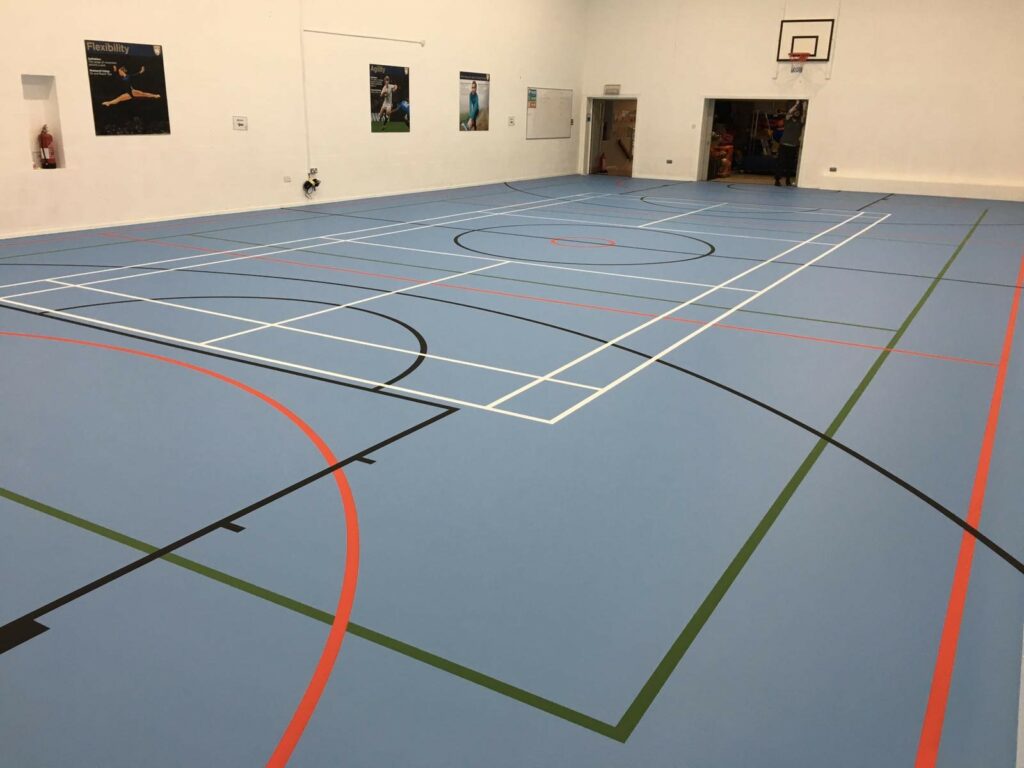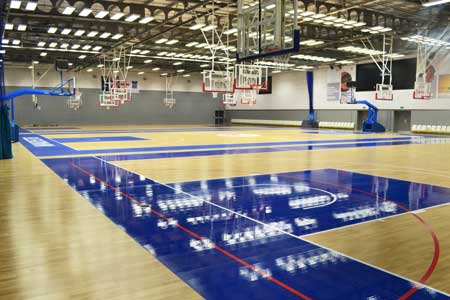Timber vs Synthetic Playing Surfaces
Comparing Sprung Synthetic Systems with Sprung Timber Floors
Commonly in the past, the usual go-to surface within a sports hall was solid timber. With advances in technology and material science the sports industry has seen a significant move towards premium engineered timber, or sprung systems finished in solid (non foam-backed) playing surfaces. DYNAMIK offer a full range of sports floor systems including premium engineered sports timber, sport linoleum, sport vinyl and seamless polyurethane (PU), therefore we have no bias to any one particular playing surface. What we have seen, however, is an ever increasing trend towards solid synthetic surfaces, installed onto our ‘Athen’ or ‘Flexi-Beam Plus’ sprung systems, especially in light of the latest ESFA requirements.
We explain the rationale in further detail below.
Sports Performance and Synthetic Surfaces
There is absolutely no compromise in sports performance between a sprung sports floor finished in timber playing surface, or a synthetic playing surface such as solid Sports Linoleum. Sprung systems such as our Athen or Flexi-Beam Plus, when finished with a solid synthetic playing surface, still incorporate all the performance benefits of timber in their sub-construction. It is also interesting to note that the majority of European countries install synthetic surfaces such as solid linoleum or vinyl onto a sprung wooden undercarriage in most of their multi-use,
community sports facilities.
If you watch top level sporting events including the Olympics you will find most sports are played on a sprung synthetic surface – the exception is Basketball where in Elite Basketball Arenas, a timber finish is required to meet FIBA 1 playing standards. DYNAMIK work very closely with NGBs and have installed both timber and synthetic surfaces within their sporting arenas.

Multi-sport & Multi-usage
Single sport specific halls are rare in an increasingly competitive market. A typical sports hall must now combine sport usage and community usage together with a range of non–sporting activities. Sport usage can range from badminton to basketball or spin class to trampoline use. This range of sporting activities imposes high demands on a sports floor. It must perform for the badminton player but must be able to resist damage from trampolines and spinning bikes which are moved across the floor.
Community use can involve local social functions whereby the floor needs to cope with spillages and stiletto heels. The hall may then be used by the school for a range of non-sporting activities, such as dining, exams, parent teacher evenings or prom nights to name but a few. A solid synthetic playing surface has the ability to deal with these nonsporting activities whilst still providing the required sports performance.
The need to protect the sport finish with carpet tiles or alternative surface protection is purely optional with a sprung synthetic surface whereas this is not the case with a sprung timber surface – floor protection must be used
in order to protect the timber from indentation and scratches as well as maintaining its warranty.
Underfloor Heating
Underfloor heating causes more movement in the floor system due to the proximity of the heat source. Given the increased dimensional stability engineered hardwood systems are better suited for underfloor heating.
Life Cycle Costs
In terms of life cycle costs there is a significant additional cost in maintaining a sprung timber floor compared to a sprung system, finished in a solid synthetic playing surface.
We estimate that over a 25 year period for an engineered timber board this can be in the range of £75 to £100/m2 and for a solid timber board in the range of £125 to £150/m2. The above covers both periodic re-lacquer seals and the required full sanding, sealing and re-line marking, which is a client requirement to maintain system warranties. The above maintenance is not required with a sprung synthetic playing surface applied to the DYNAMIK Athen or Flexi-Beam Plus sprung systems.
A DYNAMIK premium engineered sports board will benefit from much lower costs in terms of day to day maintenance given the absence of washer gaps and a less frequent need for a deep sand and reseal due to the factory applied UV-cured lacquer and the natural stability of engineered
sports boards.
The cost of maintaining a typical 600m2 solid timber floor to the manufacturer’s instructions is in the region of £72,000 over a 25 year period, the cost for a comparable engineered hardwood floor is significantly less, being in the region of £44,000.

Sports Performance
Solid timber floors only offer elasticity from the sub construction as the surface boards are very ridged, with a DYNAMIK engineered hardwood floor both the surface and the sub construction combine to give high levels of performance and user comfort.